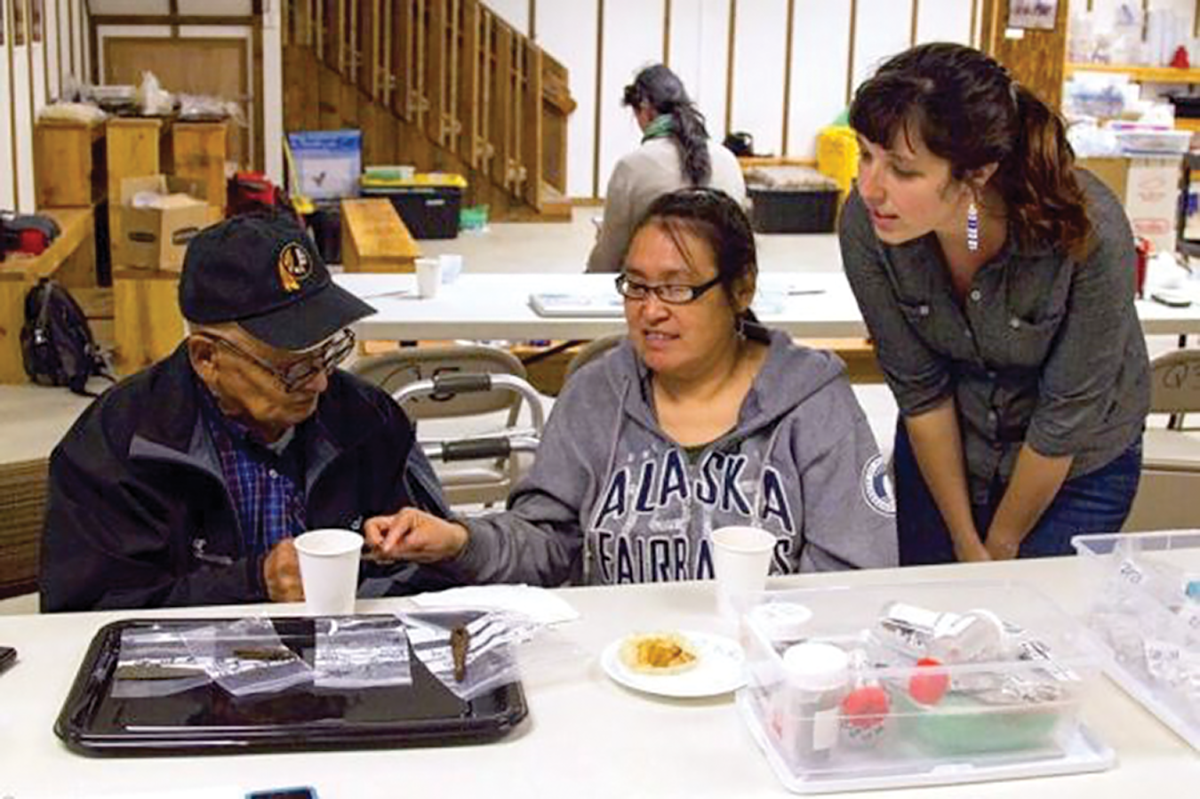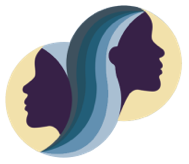
by Anna Sloan, PhD candidate, Department of Anthropology
From the air on a sunny day, Alaska’s Yukon-Kuskokwim Delta is a sight to see—a tangle of serpentine rivers winding across wavy terrain; sporadic lagoons filled with luminescent algae; every now and then some movement on the tundra, perhaps caribou; the edge of the Bering Sea shimmering in the distance. This is the landscape that surrounds Quinhagak1, a Yup’ik2 village of about 700 residents that is also home to Nunalleq, an incredibly well-preserved thirteenth–seventeenth century archaeological site. With the help of a CSWS Graduate Student Research Grant, I traveled to Quinhagak in July 2015 to collect semi-structured interview data from local residents on the subject of gender in Yup’ik lifeways. My dissertation involves translating such data into a model for how gender operated in Yup’ik communities of the past, which will aid in the archaeological analysis of Nunalleq.
Through graduate studies in archaeologies of gender, colonialism, and indigenity, I’ve learned that the contextual, intersectional concept of gender is best and most ethically explored when stakeholder communities are involved in research. For much of its disciplinary history, archaeology excluded contemporary Indigenous communities (except as subjects of study under the “white gaze”), but recent critiques from Native scholars and communities are pushing archaeologists to attend to these inequities through community-based and participatory research programs. At the same time, Native feminists have drawn attention to the ways that gender is intertwined with colonial oppressions, noting the destruction of traditional gendered lifeways as a key tactic of colonialism. With these issues in mind, I designed my dissertation project to explore the archaeology of Yup’ik gender in ways that honor Yup’ik knowledge while involving community stakeholders in data collection and interpretation. My goal for the 2015 field season was to listen to Yup’ik people’s definitions of gender and their thoughts on what gender at the ancient village of Nunalleq may have looked like.
My first research challenge was recruitment. I had visited Quinhagak during the summer of 2014 as an archaeologist participating in Nunalleq excavations, but I had never experienced the village as a cultural anthropologist looking for people to talk to. Most residents of Quinhagak know or are related to one another, and social life in the village takes place predominantly in person, with friends and family members running into each another on the street or dropping by houses for social visits. As an outsider to the community, without a network of recognizable faces, I wasn’t quite sure where to begin. To this end, I was extremely fortunate to have the help and support of Warren Jones, president of the village corporation Qanirtuuq, Inc.,3 and his assistant Louie, who provided me with phone numbers and suggested that I post a study advertisement at the corporation grocery store, one of the only shops in town and a hub of local activity. This plan worked, and by the next day Louie was fielding calls and assisting me in interview scheduling. Louie and Warren’s help in connecting me to the community really made this interview project possible.
Though I began interviews with a predetermined set of questions, I quickly gleaned that going off-script was the most fruitful method for learning from project participants. Engaging in genuine, free-flowing conversations with Quinhagak residents not only resulted in interesting data, but also proved to be the happiest part of my days in the field. Though gender was the central subject of conversation, the semi-structured interview model allowed for each participant’s own ideas, values, and voice to float to the surface. Over the course of fifteen interviews with women and men aged twenty-two to seventy-six, discussion topics ranged from the roles of mothers and fathers, the joys of hunting and fishing, ideas about ancient life in the village, the importance of education in rural communities, concerns about the survivance of the Yup’ik language, ghosts, religion, sexuality taboos, what women should do during pregnancy, the heartbreak of miscarriage, gender violence in Quinhagak, and why listening to the elders is of utmost importance to Yup’ik lifeways. In addition to audio-recording most interviews (with participant permission), I also took notes during each session and again at the end of every day in the hopes of determining what this shared knowledge indicated about the archaeology of Nunalleq.
Some strong themes began to emerge from these conversations. It was clear that many Quinhagak residents associated gender roles with subsistence tasks. Multiple participants discussing idealized mens’ roles as “providers” for their families through hunting and fishing, while archetypal Yup’ik women were tasked with processing the animals that men bring home as a result of these activities. While such associations are not novel (they are discussed in much of the literature on Yup’ik lifeways), I was struck by two aspects of these conversations on gender and subsistence: the fact that much flexibility exists within which gendered bodies actually do these subsistence tasks (e.g. men can learn to sew hides, traditionally a woman’s task, without shame), and the mutual appreciation that participants expressed for the contributions of each sex.
I asked Quinhagak residents to discuss how gender relates to the qasgi, or “men’s house,” which was a typical feature in many pre-contact Yup’ik communities and where men and boys would reside communally in winter months. Evidence for a qasgi-like structure exists at the site, so understanding how gender relates to such spaces is an important goal of my project. When I mentioned the qasgi, people had interesting responses, referring to this space as simultaneously only for men but also like a “community center” for all members of a village. Two village elders poignantly observed that the contemporary equivalent of a qasgi would be the Qanitruuq community building, the location where all of my interviews were performed and where the archaeological team did much of their work. The Qanirtuuq building is certainly not a gender-segregated space, and I wonder if the association of “qasgi” with “place for men” has been over-emphasized in the anthropological literature. This is something that my research will continue to explore.
Some of the strongest and most interesting associations apparent in interviews were those between gender and teaching and learning. Again and again, when asked about the roles of women and men in Yup’ik culture, interviewees would bring up the notion of teaching. Passing gendered skills and information down to younger generations is seen as both virtuous and crucial to the survivance of Yup’ik lifeways. Age reveals itself as an intersectional factor here, with older people bearing the responsibility of teaching the young, and the young encouraged to honor their elders.
I will return to Quinhagak in mid-July 2017 to continue this research on gender. I’m looking forward to reacquainting myself with the village and catching up with the 2015 study participants, many of whom I now consider friends. My next phase of research is aimed at creating a model for if and how Yup’ik gender (which I now know to be associated with subsistence divisions of labor, spatial dynamics, and intergenerational teaching and learning) is embodied materially through artifacts and architectures of the Nunalleq site. This research continues to be immensely rewarding, thanks mostly to the graciousness of the Quinhagak community, which is full of people deeply engaged with their heritage whose voices should be honored in its interpretation.
—Anna Sloan is a PhD candidate in the Department of Anthropology. Her research interests in gender and colonialism in Alaska Native communities span the fields of archaeology and cultural anthropology.
End Notes
1. Quinhagak, pronounced “Kwin-a-hawk” or “Kwin-hawk”, translates roughly in Yup’ik to “newly formed river.”
2. The Yup’ik are one of Alaska’s Indigenous groups, inhabiting the southwestern parts of the state.
3. Under ANCSA, or the Alaska Native Claims Settlement Act of 1971, rights to Alaska Native lands and other assets are administered via regional- and village-level corporations. Qanirtuuq, Inc. serves as the ANCSA corporation for Quinhagak and helps to sponsor the excavations at Nunalleq, amongst other cultural preservation efforts.

